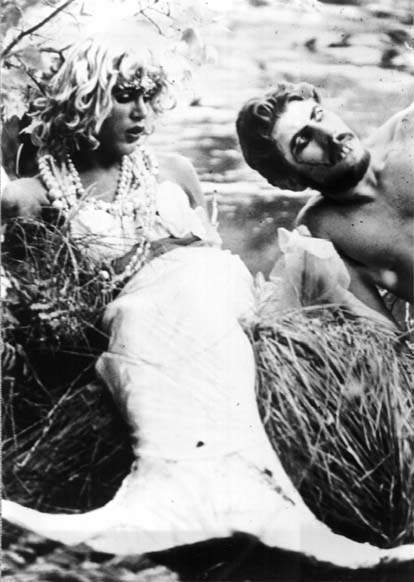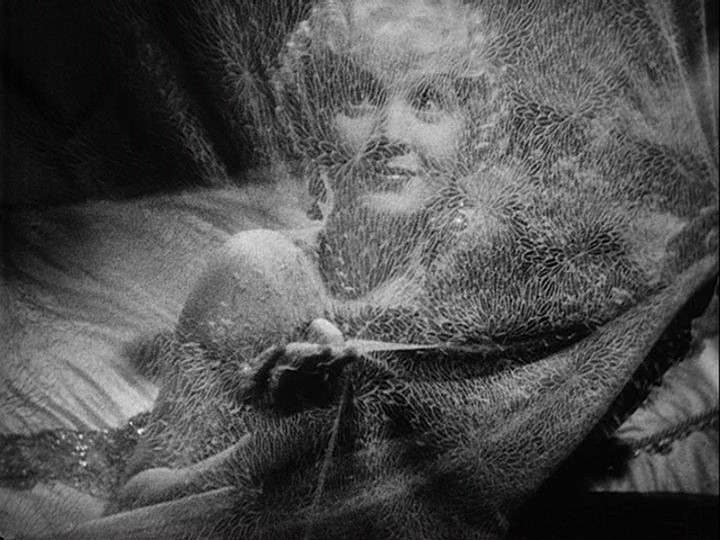On Jack Smith's Normal Love

Jack Smith has never received his dues. He is world famous in the thimble sized world of experimental film. His films will never see official distribution, and we are at a great loss for it. Without Smith, there would have never been John Waters, who gleaned (and I use this term quite politely, where another might be better suited) a great deal of what he would more commercially use as Camp from the films of Jack Smith. But then gleaning (or perhaps stealing, to use a more precise word) was not an alien approach to Smith. His films are collages of cinematic ephemera, stitched together with extremely loose narratives. An extremely impressionable youth, Smith would take those experiences that formed his adolescence and turn them back in on themselves in the landscape of his own screened conscious. And this is why they work. To use the example of The Scarlet Empress, in the film, Smith recognizes the story - which in Empress' case is the tale of Catherine the Great - yet sees its true purpose as the aesthetic revelry that Von Sternberg lavishes over his muse, Marlene Dietrich. The film isn't as much about Catherine the Great as it is about the lace curtain that surrounds her bed or the candles, melting over the exorbitantly macabre sculptures. In Smith's mind, it is a film about Dietrich (or he argued a cross-dressing Von Sternberg enacted by Dietrich) wrapped in furs and covered in jewels.
in the film, Smith recognizes the story - which in Empress' case is the tale of Catherine the Great - yet sees its true purpose as the aesthetic revelry that Von Sternberg lavishes over his muse, Marlene Dietrich. The film isn't as much about Catherine the Great as it is about the lace curtain that surrounds her bed or the candles, melting over the exorbitantly macabre sculptures. In Smith's mind, it is a film about Dietrich (or he argued a cross-dressing Von Sternberg enacted by Dietrich) wrapped in furs and covered in jewels.  So, in order to make an honest film, Smith places the central focus upon the fabric that rests between the actors and the camera, on the backdrop that places his creatures in their imaginary world. An even greater influence to Smith than the Von Sternberg/Dietrich Collaborations was the cult film figure Maria Montez. Montez was a C movie actress whose films like Cobra Woman and Arabian Nights cast her as a fiery minority goddess. Hers were the nickel and dime shows in the second rate cinemas of the forties. Her acting capabilities were non-existent, but within this, Smith recognized a camp capability of the actor to transcend her faults with a certain decorum and a drag-like self-composure. (It is also quite essential to note that Susan Sontag wrote Note On Camp the same year that Smith made his most notorious film, Flaming Creatures. A film that Sontag would publish an essay in defense of after its censorship by the US government, it is certainly with Smith (if not this film, than his role as performer and personality) in mind that Notes on Camp was written.)
So, in order to make an honest film, Smith places the central focus upon the fabric that rests between the actors and the camera, on the backdrop that places his creatures in their imaginary world. An even greater influence to Smith than the Von Sternberg/Dietrich Collaborations was the cult film figure Maria Montez. Montez was a C movie actress whose films like Cobra Woman and Arabian Nights cast her as a fiery minority goddess. Hers were the nickel and dime shows in the second rate cinemas of the forties. Her acting capabilities were non-existent, but within this, Smith recognized a camp capability of the actor to transcend her faults with a certain decorum and a drag-like self-composure. (It is also quite essential to note that Susan Sontag wrote Note On Camp the same year that Smith made his most notorious film, Flaming Creatures. A film that Sontag would publish an essay in defense of after its censorship by the US government, it is certainly with Smith (if not this film, than his role as performer and personality) in mind that Notes on Camp was written.)

Tonight I watched, for the first time, a horribly degraded copy of Jack Smith's feature length follow-up to Flaming Creatures, Normal Love. Smith is truly a master of his craft. If Flaming Creatures was a claustrophobic world of decadence and rebirth, in Normal Love Smith's creatures (here even more iconic than in the preceding film) lay siege on the garden of Eden, overturning it to, yet again, revel in the fantastic opulence of the body and, sadly, yet again, they are punished. The genius of Normal Love lies in the films' "normalcy." In Smith's world, only those things that are not faked are fraud, and cannot therefore be trusted. The women are women whether or not they are men, and when a real breast is exposed, rather than clarify the gender of the performer, one begins to distrust it for its authenticity. Smith drops the artificial noses employed in Creatures for a far greater degree of falseness. Mario Montez plays the mermaid, whose fin the viewer all too quickly takes for granted, and when, during a muddy embrace with the werewolf, her wig is accidentally removed from her head, the hair beneath becomes the lie we desire to be covered over with the truth, the platinum wig. A real pregnant belly swells to the point of obscenity, whereas the pink drag of the Pink Fairie/Cake Girl ring more sincere or "normal." When the Uncle gets a pie in the face and his fangs fall out, the narrative(chase) is paused for the real moment which finds him uncovering his face, replacing his fangs. The watermelon feast is the campy and decadent equivalent to the feast of horror in Romero's Night of the Living Dead. Here, of course, the flesh is the pink juicy casualness of the watermelon.
The first half of the film relies on the aforementioned focus on objects in space. The Girl swings on a swing set, pushed by the watermelon man. Her scarf fills the frame. After a while, they nestle on the ground and light sparklers. These sparklers, in effect, add more to the flow of the film than any narrative, mainly because of their opulent depiction and the absolute importance bestowed to them in the main structural trajectory of the film. The white finned mermaid floats in her milk bath, bejewelled in dozens of strands of pearls, wearing a white skull cap. White on white like Flaming Creatures, yet in a larger context (something innately promised by a feature length film of any variety), she holds a more meta form, presenting herself as something far greater than the many of her parts. Hers is perhaps the story which we are experiencing - a read reiterated by the cows that roam our Eden). This is Smith's most upper-cased C Cinematic moment of delivery. The bath glistens and shines. We have previously seen the mermaid paying homage to the shrine of Maria Montez. Now, Mario Montez, who, again, portrays the mermaid floats in a pool, though even she is threatened by the spider that looms threateningly above the bath.
This is a bizarre world of Mummies and Werewolves, of Cake ladies and Mermaids, but this idea of normalizing the abnormal is eventually what makes it work, and it does quite well. Smith maps a world whose oddities are far more traditional than anything we know as traditional. This is what made him such an essential contribution to the world of experimental cinema. Warhol, who apparently makes a cameo in Normal Love would never have made the same movies without him, and Warhol's films (though mainly because of his other media contributions) are the post-modern holy grail of experimental film. You will also see bits of Kenneth Anger (the white bat of Normal Love) and as I have previously mentioned, a lot of Waters. Now, if only this same honor would be given to Smith. See clips of Normal Love by clicking on the first option here. You can purchase the mediocre copy of the film that I have on dvd here

1 Comments:
Great review! You can view Flaming Creatures, Normal Love, and Scotch Tape here: http://www.ubu.com/film/smith_jack.html. The soundtrack for Normal Love is also astonishing, and I wish I was able to identify the THREE recordings in Arabic. Anyone?
Post a Comment
<< Home